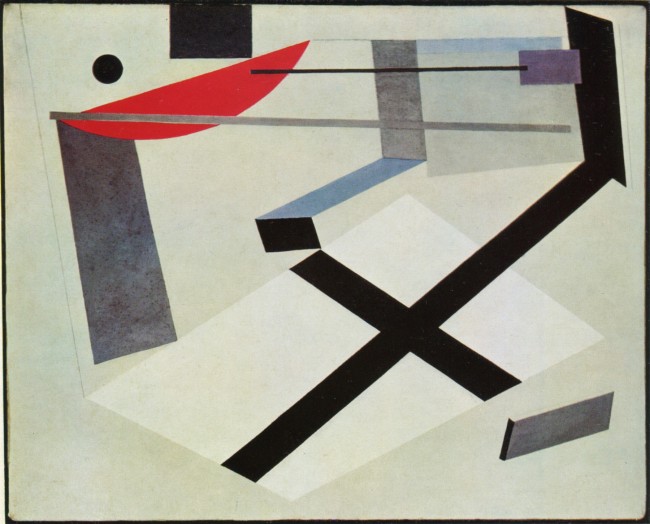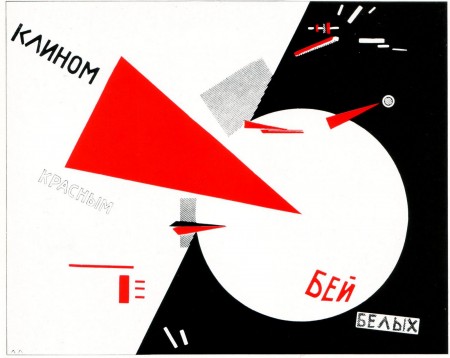
The Timken Museum of Art in San Diego presents El Lissitzky: Futurist Portfolios running from May 15 through September 7, 2014. The exhibit will feature two complete sets of El Lissitzky’s futurist portfolios of modern designs commissioned in 1923 by the Kestner Society. His portfolios consist of 20 prints, with eight intended as an archetype for future mechanical and architectural designs. The twelve remaining prints were made in commemoration of the 1913 futurist opera by his mentor, Kasimir Malevich, Victory over the Sun.
In the early 20th century, Russian abstract painter-graphic artist, Eleazar Morduchovitch Lissitzky, known as El Lissitzky, was the first generation to envision a new “radical geometry of space and movement” that blurred the limitations placed on architecture, typography and painting.
As a key figure in the Russian avant-garde, Lissitzky began designing exhibitions and Soviet propaganda, with his most notorious work being the 1919 propaganda poster Beat the Whites with the Red Wedge. He also spent time in Germany as a cultural representative of Russia producing propaganda books, posters, buildings and exhibitions for the Soviet Union.
In 1919, he was invited by the artist, Marc Chagall to be on the faculty of the Vitebsk Popular Art School. He became part of the suprematist art group UNOVIS (champions of the new art), and in 1920 was a member of INKhUK (Institute for Artistic Culture) in Moscow. A year later, he joined the Constructivist group.
In 1923, his prints followed the Bolshevik revolution with an abstract, geometric language that aligned with the idealistic principals of Soviet Communism. He established a style with abstract shapes that defined the spatial relationships in his compositions. Shapes were created in a three-dimensional space, of varying perspectives. It was a direct contrast to the notions of the Suprematist theories that emphasized shape simplification and the use of two-dimensional space.

Then, Lissitzky conceived the word, Proun. There has been much speculation of its true definition. The Spencer Museum of Art states that it is from a Latin acronym, meaning, “design for the confirmation of the new” to represent his creative works as a three-dimensional experience. The British Museum cited that it is Russian acronym meaning, “project for the affirmation of the new.” In addition, Design is History mentioned that its exact origin has never been ascertained, but that Lissitzky referred to it obscurely as “the station where one changes from painting to architecture.” Whatever its origin, the word, Proun is graphically displayed in his prints, and was first evident in his architectural “Proun Room,” which Lissitzky created in 1923 for a Berlin exhibition.
In 1932, Stalin ordered that all artists follow much stricter guidelines or be blacklisted. Lissitzky, while suffering from pulmonary tuberculosis by that time, managed to retain his position as head of exhibitions, until 1941 when he succumbed to his disease.
For the Timken exhibit, almost a century later, contemporary artist, Hideyo Okamura recreated a “Proun Room” as part of the exhibit so visitors can experience Lissitzky’s “gravity-defying sensation of geometric shapes and linear vectors.” For each El Lissitzky exhibit, Okamura takes the architectural elements of the gallery space where the prints will be exhibited into account. Her “Proun Room” for the Lissitzky prints generates an all-enveloping art experience. The space is rendered with Lissistzky’s architectural tones and shapes that wind around corners and ascend to the gallery ceiling.
The Timken’s Russian icon collection, the official art of the Imperial regime, will complement Lissitzky’s avant-garde works that were suppressed by the Soviet authorities in the 30s. The artist’s development of the ideas behind the Supermatist art movement was very influential in the development of the Bauhaus and the Constructivist art movements. Although, El Lissitzky’s stylistic approach and experimentation with production techniques developed in the 20s and 30s, his methods have been an influence on graphic designers ever since.
By: Dawn Levesque
Sources:
British Museum
Spencer Museum of Art




One thought on “El Lissitzky’s Futurist Portfolios at the Timken Museum”
I’m now not certain where you’re getting your information, but good topic. I needs to spend a while studying much more or understanding more. Thank you for great info I was searching for this info for my mission.
Comments are closed.